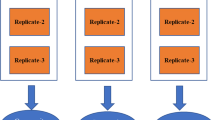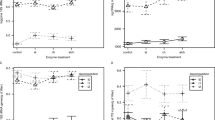Abstract
The present study was conducted to investigate the effect of decomposition site and plant litter species on the colonizing microbial communities. For this, litter bag technique using beech and spruce litter was combined with RNA-based fingerprinting and cloning. Litter bags were incubated for 2 and 8 weeks in the Ah horizon of beech and beech–spruce mixed forest sites. Although sugars and starch were rapidly lost, lignin content increased by more than 40% for beech and more than doubled for spruce litter at both soil sites at the end of the experiment. Denaturing gradient gel electrophoresis analysis of 16S and 18S rRNA RT–PCR products was used for screening of differences between bacterial and fungal communities colonizing the two litter types. Development of the microbial community over time was observed to be specific for each litter type and decomposition site. RT–PCR products from both litter types incubated in beech–spruce mixed forest site were also cloned to identify the bacterial and fungal colonizers. The 16S rRNA clone libraries of beech litter were dominated by γ-proteobacterial members, whereas spruce libraries were mainly composed of α-, β-, and γ-proteobacterial members. Ascomycota members dominated the 18S rRNA clone libraries. Clones similar to Zygomycota were absent from spruce, whereas those similar to Basidiomycota and Glomeromycota were absent from beech libraries. Selective effects of litter quality were observed after 8 weeks. The study provides an insight into the bacterial and fungal communities colonizing beech and spruce litter, and the importance of litter quality and decomposition site as key factors in their development and succession.




Similar content being viewed by others
References
Abrams, ES, Stanton, VP (1992) Use of denaturing gradient gel electrophoresis to study conformational transitions in nucleic acids. Methods Enzymol 212: 71–105
Aneja, MK, Sharma, S, Munch, JC, Schloter, M (2004) RNA fingerprinting—a new method to screen for differences in plant litter degrading microbial communities. J Microbiol Methods 59: 223–231
Aro, N, Pakula, T, Penttilä, M (2005) Transcriptional regulation of plant cell wall degradation by filamentous fungi. FEMS Microbiol Rev 29: 719–739
Berg, B, Staff, H (1980) Decomposition rate and chemical changes of Scots pine needle litter. II. Influence of chemical composition. In: Persson, T (Ed.) Structure and Function of Northern Coniferous Forests—An Ecosystem Study, Vol. 32. Ecological Bulletins, Stockholm, pp 373–390
Bjørnlund, L, Christensen, S (2005) How does litter quality and site heterogeneity interact on decomposer food webs of a semi-natural forest? Soil Biol Biochem 37: 203–213
Bruce, RJ, West, CA (1989) Elicitation of lignin biosynthesis and isoperoxidase activity by pectic fragments in suspension cultures of castor bean. Plant Physiol 91: 889–897
Buchan, A, Newell, SY, Butler, M, Biers, EJ, Hollibaugh, JT, Moran, MA (2003) Dynamics of bacterial and fungal communities on decaying salt marsh grass. Appl Environ Microbiol 69: 6676–6687
Buchan, A, Newell, SY, Moreta, JI, Moran, MA (2002) Molecular characterization of bacterial and fungal decomposer communities in a southeastern U.S. saltmarsh. Microb Ecol 43: 329–340
Chadwick, DR, Ineson, P, Woods, C, Piearce, TG (1998) Decomposition of Pinus sylvestris litter in litter bags: influence of underlying native litter layer. Soil Biol Biochem 30: 47–55
Cox, P, Fischer, PJ, Anderson, JM (1997) Experiments in fungal survival of two common pine litter colonisers. Mycologist 11: 55–58
Deacon, JW (1997) Modern Mycology. Blackwell, Boston, p 303
Dilly, O, Munch, JC (2001) Shifts in physiological capabilities of the microbiota during the decomposition of leaf litter in black alder (Alnus glutinosa (Gaertn.) L.) forest. Soil Biol Biochem 33: 921–930
Dilly, O, Bloem, J, Vos, A, Munch, JC (2004) Bacterial diversity in agricultural soils during litter decomposition. Appl Environ Microbiol 70: 468–474
Dix, NJ, Webster, J (1995) Fungal Ecology. Chapman and Hall, London, p 549
Findlay, S, Tank, J, Dye, S, Valett, HM, Mulholland, PJ, McDowell, WH, Johnson, SL, Hamilton, SK, Edmonds, J, Dodds, WK, Bowden, WB (2000) A cross-system comparison of bacterial and fungal biomass in detritus pools of headwater streams. Microb Ecol 43: 55–66
Frankland, JC (1992) Mechanisms in fungal succession. In: Carroll GC, Wicklow GC (Eds.) The Fungal Community: Its Organisation and Role in the Ecosystem. Marcel Dekker, New York, pp 383–402
Gulis, V, Suberkropp, K (2003) Effect of inorganic nutrients on relative contributions of fungi and bacteria to carbon flow from submerged decomposing leaf litter. Microb Ecol 45: 11–19
Hammel, KE (1997) Fungal degradation of lignin. In: Cadish G, Giller KE (Eds.) Driven by Nature: Plant Litter Quality and Decomposition. CAB International, Wallingford, pp 33–45
Heal, OW, Anderson, JM, Swift, MJ (1997) Plant litter quality and decomposition: and historic overview. In: Cadish G, Giller KE (Eds.) Driven by Nature: Plant Litter Quality and Decomposition. CAB International, Wallingford, pp 3–30
Heuer, H, Smalla, K (1997) Application of denaturing gradient gel electrophoresis (DGGE) and temperature gradient gel electrophoresis (TGGE) for studying soil microbial communities. In: van Elsas JD, Wellington EMH, Trevors JT (Eds.) Modern Soil Microbiology. Marcel Dekker, New York, pp 353–373
Heukeshoven, J, Dernick, R (1986) Neue Ergebnisse zum Mechanismus der Silberfaerbung. In: Radola, BJ (Ed.) Electrophorese Forum '86. Technical University of Munich, Munich, pp 22–27
Lemons, A, Clay, K, Rudgers, JA (2005) Connecting plant-microbial interactions above- and belowground: a fungal endophyte affects decomposition. Oecologia 145: 595–604
Liski, J, Perrouchaud, D, Karjalainen, T (2002) Increasing carbon stocks in the forest soils of western Europe. For Ecol Manage 169: 159–175
Martin, A, Marinissen, JCY (1993) Biological and physico-chemical processes in excrements of soil animals. Geoderma 56: 331–347
Miller, HG (1984) Dynamics of nutrient cycling in plantation ecosystems. In: Boven GD, Nambiar EKS (Eds.) Nutrition of Plantation Forest. Academic Press, London, pp 53–78
Newell, SY (2001) Multiyear patterns of fungal biomass dynamics and productivity within naturally decaying smooth cordgrass shoots. Limnol Oceanogr 46: 573–583
Paustian, K, Agren, GI, Bosatta, E (1997) Modelling litter quality effects on decomposition and soil organic matter dynamics. In: Cadish G, Giller KE (Eds.) Driven by Nature: Plant Litter Quality and Decomposition. CAB International, Wallingford, pp 313–335
Prescott, CE, Blevins, LL, Staley, CL (2000) Effects of clear-cutting on decomposition rates of litter and forest floor in forest of British Colombia. Can J For Res 30: 1751–1757
Rutigiano, FA, De Santo, AV, Berg, B, Alfani, A, Fioretto, A (1996) Lignin decomposition in decaying leaves of Fagus sylvatica L. and needles of Abies alba. Mill Soil Biol Biochem 28: 101–106
Scholle, G, Wolters, V, Joergensen, RG (1992) Effects of mesofauna exclusion on the microbial biomass in two modern profiles. Biol Fertil Soils 12: 253–260
Updegraff, DM (1969) Semimicro determination of cellulose in biological materials. Anal Biochem 32: 420–424
Wahbeh, MI, Mahasneh, AM (1985) Some aspects of decomposition of leaf litter of the seagrass Halophila stipulacea from the gulf of Aqaba (Jordan). Aquat Bot 21: 237–244
Wedderburn, ME, Carter, J (1999) Litter decomposition by four functional tree types for use in silvopastoral systems. Soil Biol Biochem 31: 455–461
White, TJ, Bruns, T, Lee, S, Taylor, JW (1990) Amplification and direct sequencing of fungal ribosomal RNA genes for phylogenetics. In: Innis MA, Gelfand DH, Sninsky JJ, White TJ (Eds.) PCR Protocols: A Guide to Methods and Applications. Academic Press, New York, pp 315–322
Wieder, RK, Lang, GE (1982) A critique of the analytical methods used in examining decomposition data obtained from litter bags. Ecology 63: 1636–1642
Wright, MS, Covich, AP (2005) Relative importance of bacteria and fungi in a tropical headwater stream: leaf decomposition and invertebrate feeding preference. Microb Ecol 49: 536–546
Acknowledgment
The study was supported by a research grant from Deutsche Forschungsgemeinschaft (DFG), Bonn, Germany (SFB 607).
Author information
Authors and Affiliations
Corresponding author
Rights and permissions
About this article
Cite this article
Aneja, M.K., Sharma, S., Fleischmann, F. et al. Microbial Colonization of Beech and Spruce Litter—Influence of Decomposition Site and Plant Litter Species on the Diversity of Microbial Community. Microb Ecol 52, 127–135 (2006). https://doi.org/10.1007/s00248-006-9006-3
Received:
Accepted:
Published:
Issue Date:
DOI: https://doi.org/10.1007/s00248-006-9006-3




